To get things started, here is the current state of the airframe I will be using for Project Inanna:
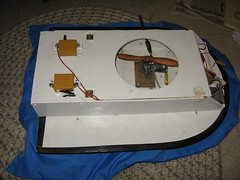 | Top-down view of the vehicle, showing the control servos aftward and the engine forward. |
 | Looking into the forward compartment, where the glow-fuel tank, receiver, and battery are kept during operation. Bit messy after six years' storage. |
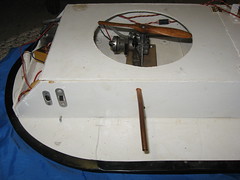 | The forward port side, showing the extended needle valve control, chargin port, and power switch. |
 | Aft section, showing in more detail the steering servo on the port side, and the diverter servo on the starboard side, as well as the hinges that allow the forward section of the top cowling to be raised for engine access. |
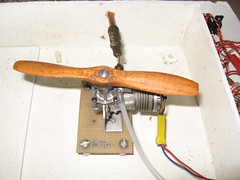 | The engine compartment. This is, if memory serves, a COX 0.12 engine with a wooden 6x3 two-bladed propeller. To the right of the image, you can see the fuel line (blue tube) and the glow-plug line (red and blue wires). |
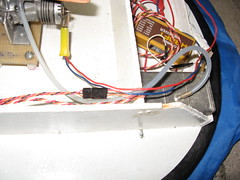 | A side look at the controls compartment, with greater detail of the controls and the really, really old-school Kraft servo connections. |
 | The view under the skirt. The six bolts go all the way through the craft and end up in the deck nuts that we in previous images. The round hole is the exhaust from the diverter and generates the actual cushion of air the craft rides on. |
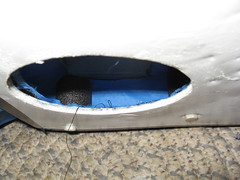 | A closer view of the air duct under the vehicle. The black object between the layers is a short chunk of 3/4" foam pipe insulation, perfect for lightweight standoffs between the upper and lower decks. |
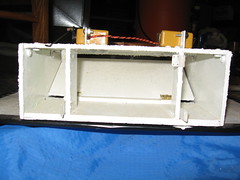 | Looking forward from directly aft of the vehicle, you can see the diverter fully open. This directs almost all of the engine's thrust into the skirt, leaving little to come out the vent on the stern for thrust. You can also see the vertical supports to which the rudders were formerly attached. |
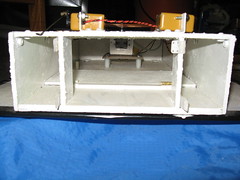 | The diverter is now fully closed. In practice, there was still enough air pressure in the upper duct to fully inflate the skirt and generate enough lifting cushion to allow the vehicle to skitter around bit. However, even fully closed off, there was still not enough thrust to make the vehicle go forward at any kind of useful speed. This is likely due to the fact that the superstructure is currently made from particle board, rather than the balsa called for by the plans upon which the vehicle is based. |
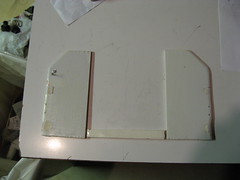 | The rudders. They are joined by a strip of the same foamboard as the upper and lower decks, to allow them synchronous motion. However, these rudders are far too small for the new design, and will end up on the scrap wood pile for use in other projects. |
No comments:
Post a Comment